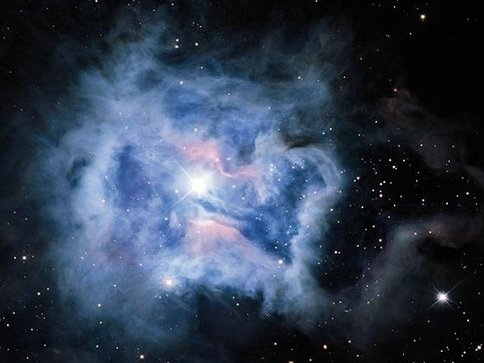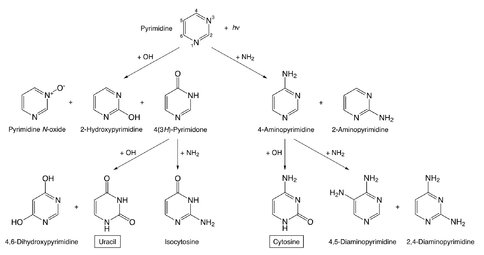2011 Annual Science Report
 NASA Ames Research Center
Reporting | SEP 2010 – AUG 2011
NASA Ames Research Center
Reporting | SEP 2010 – AUG 2011
Cosmic Distribution of Chemical Complexity
Project Summary
The central theme of this project is to explore the possible connections between chemistry in space and the origins of life. We start by tracking the formation and development of chemical complexity in space from simple molecules such as formaldehyde to complex species including amino and nucleic acids. The work focuses on molecular species that are interesting from a biogenic perspective and on understanding their possible roles in the origin of life on habitable worlds. We do this by measuring the spectra and chemistry of analog materials in the laboratory, by remote sensing in small spacecraft and by analysis of extraterrestrial samples returned by spacecraft or that fall to Earth as meteorites. We then use these results to interpret astronomical observations made with ground-based and orbiting telescopes.
Project Progress
(1) This has been a fruitful year mining the information in our PAH spectroscopic database (db). Three papers have been published to support missions such as Spitzer, SOFIA, Herschel, and JWST: i) a thorough analysis of PAH Far-IR spectra, ii) a description of how one can use the db and web tools to fit Spitzer spectra and iii) an analysis of PAH evolution across an extended astronomical object, probing their changing conditions (Figures 1 and 2). We have also added spectra of very large PAHs, ranging in size from C150 to C384, to the database. To date, the site has had 10,845 visitors from 74 countries. At least 5 separate research groups are using the most advanced tools on the database.
FIGURE 1. The PAH database has been used to unravel different aromatic components in the reflection nebula NGC 7023. Visible picture shown in Fig.2. Left: Spectra of PAH clusters (red), neutral PAHs (green) and PAH cations (blue) in the ISOCAM spectral-spatial maps of reflection nebula NGC 7023. Right: These components show different spatial distributions in this source reflecting the photo-fragmentation of PAH clusters, followed by the ionization of the free-flying PAHs as they approach the central star (indicated as a white dot).
FIGURE 2. Visible image of reflection nebula NGC 7023. The pinkish region above the star coincides with the PAH cluster distribution shown in red in Figure 1. Visible image courtesy of Dr. Adolf Witt.
(2) We have published one paper and we are working on others that describe the production of prebiotic compounds by UV irradiation of cosmic ices. The published paper appeared in Astrobiology and described work showing that the photolysis of pyrimidine in H2O ices produces a host of new compounds, including the nucleobase uracil (Figure 3). A second paper, now submitted, shows that the addition of ammonia to the ice results in the production of the nucleobase cytosine.
FIGURE 3. Our laboratory experiments show that the UV photolysis of ices that contain pyrimidine, H2O, and NH3 results in the production of numerous new molecules, including the nucleobases uracil and cytosine.
(3) Mission involvement- Co-I Scott Sandford continues to be involved with extraction, distribution, and analysis of samples from Comet 81P/Wild 2 returned by the Stardust mission (two related papers in the last year). He also continues to work as a Co-I on the Hayabusa asteroid sample return mission, which returned to Earth in June 2010, and he is now actively studying returned samples (Figure 4). The journal Science recently published a special issue on Hayabusa results. Co-I Sandford is a member of the recently selected OSIRIS-Rex Asteroid Sample Return Mission, where he will assume numerous responsibilities including running the science team that will study the organics in the returned samples. Co-I Andrew Mattioda is a member of the Science Team for the O/OREOS (Organisms/ORganics Exposure to Orbital Stresses), NASA’s first Astrobiology Small Payloads mission, which launched on November 19, 2010. He and Nathan Bramall are working on the SEVO (Space Environment Viability of Organics) component for O/OREOS. Numerous talks have been given and one SEVO related paper has been published this year with several more publications in preparation. The O/OREOS nominal mission ended in May 2011 and is now in an extended mission focusing on the chemical evolution of astrobiologically-relevant molecules.
FIGURE 4. Measurements of the relative mineral compositions in the samples returned from asteroid Itokawa demonstrate, for the first time, a clear link between S-class asteroids and the LL Ordinary Chondrite meteorite class (Figure taken from Nakamura et al. 2011).
This year Co-I Mattioda, working with Pascale Ehrenfreund (Wisconsin team), supervised the work of a graduate student, Anthony Young, at Santa Clara University. Mr. Young was awarded an NAI fellowship to fund his mission operations graduate work on the O/OREOS space mission at Santa Clara University. Mr. Young gave a presentation of this work at the Ames NAI team meeting in July 2011.
Publications
-
Bera, P. P., Nuevo, M., Milam, S. N., Sandford, S. A., & Lee, T. J. (2010). Mechanism for the abiotic synthesis of uracil via UV-induced oxidation of pyrimidine in pure H[sub 2]O ices under astrophysical conditions. J. Chem. Phys., 133(10), 104303. doi:10.1063/1.3478524
-
Boersma, C., Bauschlicher, C. W., Ricca, A., Mattioda, A. L., Peeters, E., Tielens, A. G. G. M., & Allamandola, L. J. (2011). POLYCYCLIC AROMATIC HYDROCARBON FAR-INFRARED SPECTROSCOPY. The Astrophysical Journal, 729(1), 64. doi:10.1088/0004-637x/729/1/64
-
Bouwman, J., Cuppen, H. M., Steglich, M., Allamandola, L. J., & Linnartz, H. (2011). Photochemistry of polycyclic aromatic hydrocarbons in cosmic water ice. A&A, 529, A46. doi:10.1051/0004-6361/201015762
-
Bouwman, J., Mattioda, A. L., Linnartz, H., & Allamandola, L. J. (2010). Photochemistry of polycyclic aromatic hydrocarbons in cosmic water ice. A&A, 525, A93. doi:10.1051/0004-6361/201015059
-
Chiar, J. E., Pendleton, Y. J., Allamandola, L. J., Boogert, A. C. A., Ennico, K., Greene, T. P., … Eriksson, K. (2011). ICES IN THE QUIESCENT IC 5146 DENSE CLOUD. The Astrophysical Journal, 731(1), 9. doi:10.1088/0004-637x/731/1/9
-
Clemett, S. J., Sandford, S. A., Nakamura-Messenger, K., HÖRZ, F., & McKAY, D. S. (2010). Complex aromatic hydrocarbons in Stardust samples collected from comet 81P/Wild 2. Meteoritics & Planetary Science, 45(5), 701–722. doi:10.1111/j.1945-5100.2010.01062.x
-
Nakamura, T., Noguchi, T., Tanaka, M., Zolensky, M. E., Kimura, M., Tsuchiyama, A., … Kawaguchi, J. (2011). Itokawa Dust Particles: A Direct Link Between S-Type Asteroids and Ordinary Chondrites. Science, 333(6046), 1113–1116. doi:10.1126/science.1207758
-
Nuevo, M., Milam, S. N., Sandford, S. A., De Gregorio, B. T., Cody, G. D., & Kilcoyne, A. L. D. (2011). XANES analysis of organic residues produced from the UV irradiation of astrophysical ice analogs. Advances in Space Research, 48(6), 1126–1135. doi:10.1016/j.asr.2011.05.020
-
Ricca, A., Bauschlicher, C. W., & Allamandola, L. J. (2011). PROTONATED POLYCYCLIC AROMATIC HYDROCARBONS REVISITED. The Astrophysical Journal, 727(2), 128. doi:10.1088/0004-637x/727/2/128
-
Ricca, A., Bauschlicher, J. ,. C. W., & Allamandola, L. J. (2011). THE INFRARED SPECTROSCOPY OF POLYCYCLIC AROMATIC HYDROCARBONS WITH FIVE- AND SEVEN-MEMBERED FUSED RING DEFECTS. The Astrophysical Journal, 729(2), 94. doi:10.1088/0004-637x/729/2/94
-
Rosenberg, M. J. F., Berné, O., Boersma, C., Allamandola, L. J., & Tielens, A. G. G. M. (2012). Coupled blind signal separation and spectroscopic database fitting of the mid-infrared PAH features (Corrigendum). A&A, 537, C5. doi:10.1051/0004-6361/201016340e
-
Sandford, S. A., Milam, S. N., Nuevo, M., Jenniskens, P., & Shaddad, M. H. (2010). The mid-infrared transmission spectra of multiple stones from the Almahata Sitta meteorite. Meteoritics & Planetary Science, 45(10-11), 1821–1835. doi:10.1111/j.1945-5100.2010.001096.x
-
Tsuchiyama, A., Uesugi, M., Matsushima, T., Michikami, T., Kadono, T., Nakamura, T., … Kawaguchi, J. (2011). Three-Dimensional Structure of Hayabusa Samples: Origin and Evolution of Itokawa Regolith. Science, 333(6046), 1125–1128. doi:10.1126/science.1207807
-
Zolensky, M., Herrin, J., Mikouchi, T., Ohsumi, K., Friedrich, J., Steele, A., … Shaddad, M. H. (2010). Mineralogy and petrography of the Almahata Sitta ureilite. Meteoritics & Planetary Science, 45(10-11), 1618–1637. doi:10.1111/j.1945-5100.2010.01128.x
- Allamandola, L.J. PAHs and Astrobiology. In: Joblin, C. & Tielens, A.G.G.M. (Eds.). PAHs and the Universe. Vol. EAS Publications Series, 46.
- Tielens, A.G.G.M. & Allamandola, L.J. Cool Interstellar Physics and Chemistry. In: Khriachtchev, L. (Eds.). Physics and Chemistry at Low Temperature. Pan Stanford Publishing.
-
PROJECT INVESTIGATORS:
-
PROJECT MEMBERS:
Murthy Gudipati
Co-Investigator
Andrew Mattioda
Co-Investigator
Scott Sandford
Co-Investigator
Max Bernstein
Collaborator
Jan Cami
Collaborator
Jamie Cook
Collaborator
Jason Dworkin
Collaborator
Els Peeters
Collaborator
Christiaan Boersma
Postdoc
Nathan Bramall
Postdoc
Amanda Cook
Postdoc
Christopher Materese
Postdoc
Michel Nuevo
Postdoc
Joseph Roser
Postdoc
-
RELATED OBJECTIVES:
Objective 1.1
Formation and evolution of habitable planets.
Objective 2.1
Mars exploration.
Objective 2.2
Outer Solar System exploration
Objective 3.1
Sources of prebiotic materials and catalysts
Objective 3.2
Origins and evolution of functional biomolecules
Objective 3.4
Origins of cellularity and protobiological systems
Objective 4.3
Effects of extraterrestrial events upon the biosphere
Objective 7.1
Biosignatures to be sought in Solar System materials
Objective 7.2
Biosignatures to be sought in nearby planetary systems




